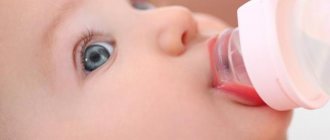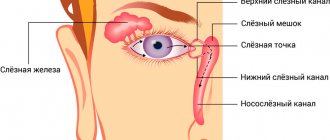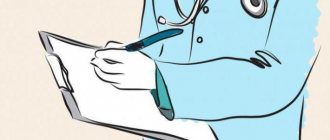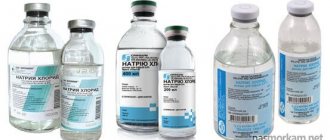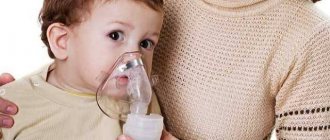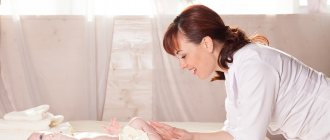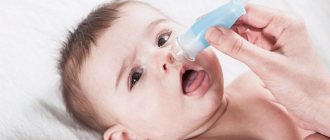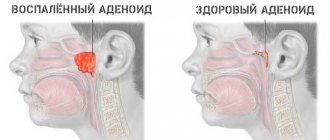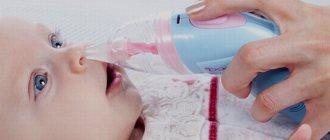Rinsing your child's nose with saline solution is the most effective and harmless way to get rid of a runny nose at home. Unlike an adult, it is usually difficult for a child to determine what exactly is bothering him and why water is flowing from his nose or, conversely, it is very blocked. Difficulty breathing is the first sign of a viral infection or a common cold. But there are other reasons: for example, allergies.
The appearance of mucus indicates that there is a problem, and the body is actively fighting it. Transparent liquid secretions delay the passage of germs, allergens and viruses. Their transformation into thick green snot is dangerous - at this stage, mucus, as an immune barrier, no longer works.
A runny nose cannot be ignored. Unfortunately, it will not go away on its own. It has plenty of side effects: moodiness, headache, general malaise, etc. You can't do without quick and effective help.
When does a child need to rinse his nose?
A saline solution used to rinse a child's nose moisturizes and cleanses the mucous membrane. The procedure is indicated not only for the active treatment of a runny nose, but also as a means of regular hygiene. This is the easiest and most affordable way to help your child cope with a runny nose or nasal congestion.
| Symptoms | Effect of washing | Regularity of the procedure |
| Clear liquid discharge | Constant hydration ensures the protective effect of mucus, its desired consistency and rapid removal | Every 30-40 minutes except for sleep. There is no need to specially wake up the child in order to comply with the treatment regimen. |
| Thick green or yellow mucus | The risk of secondary inflammation and complications is reduced. Accumulation of mucus, purulent formations, old clots, and along with them germs and viruses are removed. The mucous membrane recovers quickly | At intervals of half an hour, 1-2 hours after meals. Do not rinse during sleep |
| For prevention | The nasal passages and sinuses are cleansed, clots and crusts are removed, the mucous membrane is moisturized, and its protective function is supported. | 1 time a day in the morning while washing (before breakfast!). Maybe not every day |
To fully restore respiratory function, it is necessary to determine the exact cause of the runny nose and carry out a course of treatment under the supervision of a doctor. Proper rinsing of a child’s nose is just one of the procedures. Unlike medications, it can be carried out independently, without a doctor’s prescription, from infancy.
Treatment frequency
The respiratory system can be considered fully formed when a person reaches 12 years of age. Adults, therefore, can irrigate the mucous membrane as often as they consider necessary. With children everything is different: more often in their case does not mean better.
The frequency of the procedure, again, depends on age: up to 12 years, no more than 4 doses per day are allowed, up to 6 years, no more than 3. More often, you can act only according to the instructions of the attending physician: sometimes, in order to provide emergency assistance to the baby or speed up the healing process, the doctor prescribes the procedure every 30-50 minutes.
If severe congestion is observed, before rinsing, you need to drip a vasoconstrictor drug into the nostrils: Naphthyzin, Otrivin, Nazivin, etc. These are selected in accordance with the recommendations of a pediatrician or otolaryngologist.
It is not advisable to perform the procedure at night, since in some cases mucus comes out of the nostrils after 15-30 minutes. By falling asleep with a lot of moisture in the nasal passages, children of any age are at risk of developing otitis media.
Solution for rinsing a child’s nose at home
A saline solution is recommended as a nasal rinse for children. It is better to purchase it at the pharmacy: special preparations based on sea water have a balanced composition. There are a number of nuances associated with this:
- Ready-made preparations based on sea water. Preparations such as Sialor Aqua do not require preparation. Washing can be done immediately after opening the ampoule. The salt concentration in it is approximately 6.5 g of salt per 1 liter of water. This saturation allows you to avoid unpleasant sensations in the form of burning. Children's noses are very sensitive to excess salt. If you overdo it once and cause discomfort, it will be difficult to rinse later. With the ready-made solution "Sialor Aqua" such a situation is excluded. The concentration is optimal even for rinsing the nose of an infant. The package contains 10 anatomical ampoules with sea water - each contains a single dose. One is enough for one-time use.
Sea water for rinsing the nose Sialor Aqua
- Homemade solution of table or sea salt for rinsing the nose of children. For 1 liter of warm (not hot!) boiled water, 1 tsp is required. salt (table or sea salt without additives). This corresponds to 9 g of salt per 1 liter of water. The composition is saturated with sodium and chlorine salts, enriched with magnesium, zinc, potassium, calcium and normalizes the natural functioning of cells. When the salt concentration is exceeded, a burning sensation is felt. This is extremely unpleasant for the baby, so you should not increase the amount of salt when preparing the solution. It won't make him any more effective.
Neither one nor the other composition has side effects, overdose is excluded. At the same time, you can quickly use the ready-made product without doubting how balanced its composition is. It is conveniently and economically packaged - no pipette or syringe is needed for irrigation.
How to properly rinse your nose with sea salt instructions
To carry out the procedure, you need to take any container with a narrow and smooth neck, so that it fits into one nasal passage without any problems. You can use a regular kettle for brewing tea, a neti pot, a syringe or a disposable syringe. Which device is chosen does not matter; it should be convenient for the patient. But you need to know how to properly rinse your nose with the solution.
“Grandma’s” method of washing
If you don’t have anything convenient and suitable at hand, you can rinse your nose the “grandmother’s” way. This procedure is easy to do even not at home. Sea salt for nasal rinsing is used as follows:
- A teaspoon of the product is stirred in water until completely dissolved.
- The prepared salt solution is scooped up with the palm of your hand.
- The fingers of the second hand press one nostril, and the opposite hand slowly draws in liquid from the palm.
- If the actions are correct, the solution will flow out through the mouth.
- Next, the procedure is carried out with the other nostril.
This washing method is quite simple, but is not suitable for everyone. For small children and infants, other methods should be used.
Using a kettle
The procedure is best carried out in the bathroom. They do it as follows:
- Add salt to a teapot or neti pot and dilute it with water.
- The head is tilted over the sink and turned to one side.
- The spout of the teapot is inserted into the nostril located on top.
- If everything is done correctly, the liquid will flow out of the parallel nostril.
- Next, all actions are repeated, tilting and turning the head in the opposite direction.
After washing, you should lie down for a while and rest. It is not recommended to go out into the fresh air after the procedure.
Using a syringe, douche
Other suitable devices can be used to rinse the nose. It is very convenient to carry out the manipulation using a regular syringe or a medical syringe.
- Use the selected device to draw up the solution.
- Then the head is bowed over the bathtub or sink and the tip of the bulb or syringe is inserted into the nostril.
- After slowly squeezing the syringe or pressing the syringe plunger, liquid will begin to flow into the nasal passage and flow out through the other.
- All steps are repeated by inserting the device from the second side.
How to rinse a child's nose at home?
The easiest way to explain to a child how to rinse the nose and why this procedure is needed in general is to show it to yourself. Attempts to rinse your nose quickly, strictly and without explanation will not work. As soon as he suspects the possibility of pain, and the syringe and douche are associated with it, all mother’s efforts will be nullified.
The technology of introduction and irrigation is simple, but requires strict consistency. You need to do the following:
- Place the child facing the sink.
- Tilt his head over it, slightly moving it forward and to the side, without placing it on his shoulder.
- Inject the sea salt solution into the child's upper nostril. When using a pipette, insert the whole one into one nostril; syringe - up to 2 ml. Using ready-made Sialor Aqua bufus, count 2 drops for each nostril
- If the head is positioned correctly, water with residual mucus, crusts, pus, etc. will flow out of the lower nostril.
Scheme for rinsing the nose with saline solution
To rinse a child’s nose with a runny nose, a single injection of the solution is sufficient. There is no need to repeat several times in a row to enhance the effect. It is better to carry out the procedure several times during the day. Following the recommendations for the ratio of water and salt guarantees painlessness. Having tried it once, the baby will not be afraid to rinse his nose, especially when he feels that breathing has become easier.
How to make your own saline solution
Making a solution to rinse your nasal passages is very simple. In 1 liter of boiled water you need to dissolve 2 teaspoons of salt.
Of course, for these purposes it is better to take sea salt rather than table salt, but when choosing, pay attention that it does not contain flavors, fragrances and dyes. Sea salt without additives is usually sold in grocery stores along with food
However, if you urgently need to rinse your nasal passages with salt (for example, when exposed to allergens), you can also take food
Sea salt without additives is usually sold in grocery stores along with food salt. However, if you urgently need to rinse your nasal passages with salt (for example, when exposed to allergens), you can also take food grade salt.
The resulting solution must be filtered through cheesecloth. Before manipulation, the solution should be slightly warmed to 30-36 degrees. This is a simple recipe for a solution used to irrigate the nasal passages in adults. For children, you need to prepare a less concentrated solution.
To give the solution additional antimicrobial properties, add iodine and soda to it. The medicinal saline solution is prepared as follows. In 1 liter of warm boiled water, dissolve one teaspoon of salt and soda and add 1 drop of iodine. The resulting solution must be filtered.
The liquid prepared in this way helps:
- Relieve swelling;
- Remove viscous mucus;
- Reduce the inflammatory process.
Features of nasal rinsing for children under one year old
It is more difficult to rinse the nose of a very young child than for someone older in age. It will not be possible to explain how to behave. Show too. Everything needs to be done gently, quietly, without sudden movements. Many mothers are afraid to carry out any medical procedures on their own at first, for fear of harming or causing pain to the baby, so in this situation we recommend not to worry and adhere to the following rules:
- Buy a saline solution for rinsing the child’s nose marked 0+.
- Place the child on his back.
- Turn the head to the side.
- Place 2 drops into the upper nostril.
- Lift the head so that the residue flows out through the lower nostril.
- Repeat with the other nostril.
At the end of the procedure, you can clean the nose with a cotton swab soaked in baby oil. It will soften the mucous membrane, eliminate discomfort and allow you to remove dried crusts. Children under one year old do not need to frequently drip the solution to rinse the nose - 2-3 times a day is quite enough. As soon as the nose breathes normally and the discharge is noticeably reduced, rinsing can be left only as a morning hygiene procedure.
Contraindications for nasal rinsing
Before starting the procedure, objectively assess the child’s condition. It cannot be carried out categorically in the following cases:
- Severe swelling that interferes with breathing.
In this case, there is a risk of saline solution getting into the middle ear and causing an infection. First you need to eliminate the swelling.
- Otitis.
You should not rinse your nose if you have otitis media. We only recommend that you carefully instill the drops.
- Allergy.
The manifestation and development of an allergic reaction in children is unpredictable.
- Fragile blood vessels and, as a result, frequent nosebleeds.
- Formations in the nasal cavity.
- Deviation of the nasal septum.
You can go outside no earlier than 30 minutes after the end of the procedure. Water remaining in the sinuses can cause a cold or inflammation.
Having perfected the technique, mothers often include rinsing the nose with saline solution for children over one year old who have a runny nose in their list of daily hygiene procedures. You can maintain the working condition of the mucous membrane by other methods. For example, additional air humidification during the heating season, regular walks outside, and compliance with the drinking regime.
Benefits of the procedure
Is it right to rinse a child’s nose as soon as the first symptoms of a runny nose appear? Definitely, since the procedure is the key to defeating the disease without the use of antibiotics. By the way, doctors classify it not only as a therapeutic measure, but also as a hygienic measure: the procedure allows you to easily remove all excess from the nasal passages and makes it easier for the child to breathe.
Some doctors recommend rinsing the nose of young patients every day, especially during the cold season. This is necessary to prevent ARVI, moisturize the mucous membrane and cleanse the nose of dust, viruses and allergens.
Unfortunately, in some situations it is not possible to perform rinsing despite its many advantages. Thus, pediatricians impose taboos on otitis media, polyps, and deviated septum. Some issues can be eliminated by visiting an otolaryngologist and undergoing timely treatment.
